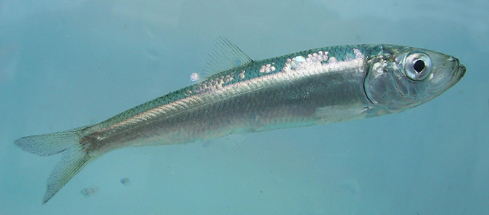Marine forage fishes in Puget Sound
This is the executive summary from a technical report produced for the Puget Sound Nearshore Partnership on Valued Ecosystem Components (VEC). The entire document is included as a PDF with this summary.

Forage fishes are small, schooling fishes that are key prey items for larger predatory fish and wildlife in a marine food web. In Puget Sound, forage fish species occupy every marine and estuarine nearshore habitat. Because of their role as critical prey species, including for economically important predators such as salmon, recent attention has been paid to their conservation and protection. Nearshore habitats are of special concern, because many species use them for spawning.
Pacific herring (Clupea pallasi), surf smelt (Hypomesus pretiosus), Pacific sand lance (Ammodytes hexapterus), and their critical spawning habitats, all commonly occur within the nearshore zone of Pacific Northwest beaches. Within the Puget Sound Basin, where their spawning areas have been most completely mapped, each species appears to use approximately 10 percent of the shoreline spawning habitat during the year. Some, like herring, spawn in only a few geographically disjunct areas, whereas surf smelt and sand lance have widespread spawning grounds. Each species has particular habitat requirements for spawning; for example, a relatively restricted sediment grain size, particular tidal heights, or specific vegetation types. For all species, however, only a fraction of the apparently appropriate habitat area within Puget Sound is actually used. Some species tend to use the same beaches annually. Adjacent nearshore habitats are used as nursery grounds by all three species.
Other forage fish species do not spawn on Puget Sound beaches but use nearshore ecosystems in other ways. Northern anchovy (Engraulis mordax) are pelagic schooling fish that spawn and incubate their eggs in open water. Eulachon ("Columbia River smelt", Thaleichthys pacificus) and longfin smelt (Spirinchus thaleichthys) are anadromous, using gravel in freshwater streams for their spawning habitat. Longfin smelt stocks are known to spawn in Puget Sound Basin rivers (Nooksack and Cedar), and its non-spawning life stages may occur in the marine nearshore zone. These species represent the largest biomass in Lake Washington.
Little is known about any forage fish species away from their spawning grounds. Herring appear to be either resident or migratory but generally do not persist in the nearshore system in large schools after spawning. Herring spawning biomasses have been closely monitored and have stayed moderately stable for 20 years. Other species have not been monitored soundwide, and regular monitoring of some spawning beaches has only recently been initiated. However, spawning beaches are vulnerable to a wide variety of impacts from human development, especially removal of riparian vegetation and processes such as armoring and dredging that change the sediment quality and quantity in the intertidal and shallow subtidal zones. This means that these valued ecosystem components must be considered at risk and in need of conservation and restoration actions.

